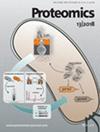人类胚胎干细胞中与染色质相关的 TCF7L1 复合物的特征
IF 3.4
4区 生物学
Q2 BIOCHEMICAL RESEARCH METHODS
引用次数: 0
摘要
人类胚胎干细胞(hESC)类似于植入后早期人类胚胎中的多能上胚层细胞,代表了多能性的 "激活 "状态。转录因子TCF7L1是一个小的蛋白家族成员,被称为T细胞因子/淋巴细胞增强因子(TCF/LEF),是WNT信号通路的下游成分。WNT 通路的转录输出部分是由 TCF/LEF 与 WNT 通路的另一个成分 β-CATENIN 共同调节的。由于 TCF7L1 在多能性调控中发挥着重要作用,我们开始利用内源蛋白快速免疫沉淀技术(RIME)鉴定与 TCF7L1 结合在 hESC 染色质上的相关蛋白复合物。数据可通过蛋白质组交换(ProteomeXchange)获得,标识符为 PXD047582。这些数据确定了 TCF7L1 在染色质上的已知伙伴和新伙伴,并为 TCF7L1 和多能性本身可能如何受到调控提供了新的见解。本文章由计算机程序翻译,如有差异,请以英文原文为准。
Characterization of a chromatin‐associated TCF7L1 complex in human embryonic stem cells
Human embryonic stem cells (hESCs) resemble the pluripotent epiblast cells found in the early postimplantation human embryo and represent the “primed” state of pluripotency. One factor that helps primed pluripotent cells retain pluripotency and prepare genes for differentiation is the transcription factor TCF7L1, a member of a small family of proteins known as T cell factors/Lymphoid enhancer factors (TCF/LEF) that act as downstream components of the WNT signaling pathway. Transcriptional output of the WNT pathway is regulated, in part, by the activity of TCF/LEFs in conjunction with another component of the WNT pathway, β‐CATENIN. Because TCF7L1 plays an important role in regulating pluripotency, we began to characterize the protein complex associated with TCF7L1 when bound to chromatin in hESCs using rapid immunoprecipitation of endogenous proteins (RIME). Data are available via ProteomeXchange with identifier PXD047582. These data identify known and new partners of TCF7L1 on chromatin and provide novel insights into how TCF7L1 and pluripotency itself might be regulated.
求助全文
通过发布文献求助,成功后即可免费获取论文全文。
去求助
来源期刊

Proteomics
生物-生化研究方法
CiteScore
6.30
自引率
5.90%
发文量
193
审稿时长
3 months
期刊介绍:
PROTEOMICS is the premier international source for information on all aspects of applications and technologies, including software, in proteomics and other "omics". The journal includes but is not limited to proteomics, genomics, transcriptomics, metabolomics and lipidomics, and systems biology approaches. Papers describing novel applications of proteomics and integration of multi-omics data and approaches are especially welcome.
 求助内容:
求助内容: 应助结果提醒方式:
应助结果提醒方式:


